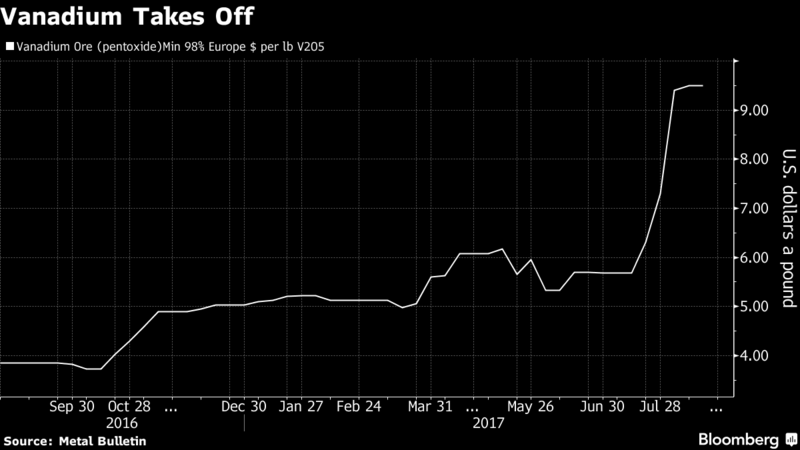First it was lithium.
Then cobalt.
It is now vanadium’s turn.
We had multiple wins with lithium (Lithium X — 1,480%, Millennial Lithium — 112%). Our cobalt play — First Cobalt — just started trading again after announcing multiple acquisitions and consolidating a major cobalt district. We’re up 20% on that with much more ahead.
Now we have a vanadium play. It comes from the same group that brought us Lithium X and First Cobalt.
The deal has an extremely tight structure with only 5.4 million shares out pre-financing. More on the company in a second. First, a vanadium lesson.
Vanadium Takes Off
A Bloomberg article that ran August 23 declared: It’s Party Time for the Metals No One Knows About. It began:
It’s turning out to be a great year for minor metals.
Rechargeable-battery ingredient cobalt has gained 83 percent, while ruthenium, used in the chemical industry and electronics, is up 63 percent. The latest star is vanadium, an obscure silvery-grey metal thought to have been used to harden steel as far back as the Crusades.
 (Click to Enlarge)
(Click to Enlarge)
Vanadium prices are up 89% in 2017. And that’s after doubling in 2016 after three years of declines.
The short-term driver is a proposal in China to increase the amount of vanadium required in construction steel. News is expected on that next month.
Right now, ~90% of vanadium is used in steel construction. But it is only used in 9% of all the world's steel. Demand from steel is expected to grow as more countries incorporate vanadium steel into their infrastructure plans.
A new source of growth is expected from the battery market.
Like with lithium and cobalt, it is expected that demand for vanadium from the rechargeable battery market will soon explode. Some mainstream firms, like Pala Investments, forecast demand will grow 10-fold from 2015-2025.
It’s the main ingredient in vanadium redox flow batteries. They aren’t used in cars. Instead, these are batteries meant to store large amounts of electricity produced by intermittent sources like wind and solar. We don’t need to cover the ascent of renewable energy… it’s happening.
Vanadium redox batteries allow companies to sell solar power at night and wind power when it’s calm. They are non-flammable, environmentally friendly, have 10,000-cycle lifetimes, and retain 90% of their capacity over 20 years.
The cost of vanadium relative to lithium batteries is higher, at $300-$500 per kilowatt-hour versus ~$200 per kWh. But those costs have been halved in the past three years and are set to come down further.
In the past few years hundreds of millions of dollars have been raised in early-round funding for vanadium battery companies. UniEnergy raised $25 million. Imergy Power Systems raised over $100 million. Vionx Energy, which has ties to United Technologies and Siemens, raised $58 million.
- [Editor:Wang Linyan]



 Save
Save Print
Print Daily News
Daily News Research
Research Magazine
Magazine Company Database
Company Database Customized Database
Customized Database Conferences
Conferences Advertisement
Advertisement Trade
Trade

















Tell Us What You Think